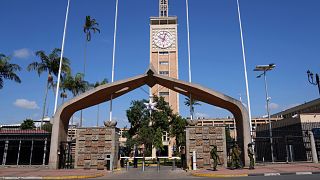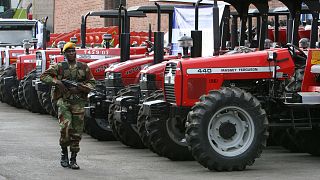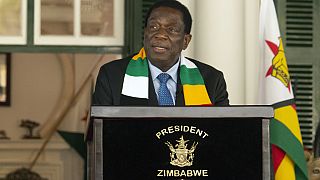Zimbabwe
The United Nations has warned that over a 100 million people could be affected by extreme weather patterns, El Nino and La Nina.
#ElNiño & #LaNiña: What you need to know about the looming crisis https://t.co/1rmqNysY33 v/
— Kent Page (KentPage) July 13, 2016uniceflive#Africa pic.twitter.com/D3XDJenXb3
The Food and Agriculture Organisation estimates that more than 60 million people, two thirds of them in east and southern Africa, are facing food shortages because of droughts linked to El Nino, a climate phenomenon that occurs when the Pacific Ocean becomes abnormally warm.
#ElNino & #LaNina are real disasters, that corrode abilities of communities to survive – UN special envoy
— FAOKnowledge (FAOKnowledge) July 13, 2016AmbMKamaupic.twitter.com/tWmUa2LoZu
The impact of La Nina, when waters in the eastern Pacific Ocean cool after a phase of El Nino, is not as severe – but La Nina has also been linked to floods and droughts.
Already rice crops across Southeast Asia, cocoa fields in Ghana, coffee in Indonesia and sugar cane fields in Thailand have dried up.
In Zimbabwe’s Chivi district, farmers have lost entire crops as the country recorded the driest season in recent years.
Walter Mhlaba, a farmer said he “sold most of the cattle because they were starving to death. I couldn’t fetch much from them, just $30 or $20. One of them fell and died in front of the buyer. I have dug many graves for the cattle. There is one over there. Some of them died when giving birth. The placenta would fall off because of starvation,”
About 8000 Zimbabwean farmers are receiving support from a fund set up by various agencies.
David Phiri, the FAO sub-regional co-ordinator, for Southern Africa said,
“The effects of El Nino, and a bad drought last year already, means that there’s been two bad seasons. So we expect that even next season – even if it is good – there will still be effects of these two seasons because farmers may not always have the seeds that they will need, some of the livestock will have died so they will need to restock. So normalcy may not return until about two seasons from now”.
The effects of the 2015-2016 El Nino has also had an impact on children, with many suffering hunger and malnutrition following severe droughts and floods.
#ElNiño #LaNiña impact on children to worsen as malnutrition, disease spread: https://t.co/FLXMHUIAQm v/
— Kent Page (KentPage) July 11, 2016uniceflivepic.twitter.com/l9nY3kA5hd
UNICEF says La Nina could further worsen the crisis that is affecting millions of children in some of the most vulnerable communities.
“There is, you know almost 200,000 people who are in immediate need and whose challenges are very real; to do with food, with water, to do with their basic livelihoods.
These are people who, without aid, would probably not live, literally, to see the next season, as opposed to the bulk of the population that might struggle, but these are the ones we don’t want to leave behind because they are particularly vulnerable”, said Macharia Kamau, the UN Envoy On El Nino.
The FAO says almost $4 billion is needed to meet the humanitarian demands of countries affected by El Nino.
The United Nations has called on governments and the international community to increase efforts to boost the resilience of “highly vulnerable” communities who are struggling to feed themselves, as well as to help them prepare for La Nina.
Reuters











Go to video
Immunization at risk: Global health leaders urge action amid rising disease outbreaks
00:53
Brazil eyes global food leadership amid U.S.-China trade tensions
Go to video
Oligui Nguema: A breakthrough or continuity for Gabon? [Business Africa]
Go to video
A booming market, but lacking data: Africa's challenge [Business Africa]
Go to video
Pics of the day: April 01, 2025
01:54
Uganda: the infiltration of plastics into agricultural fields and food raise concern